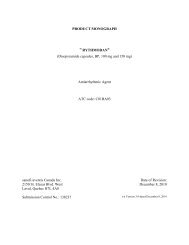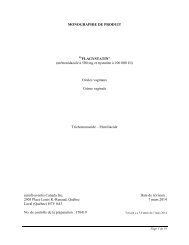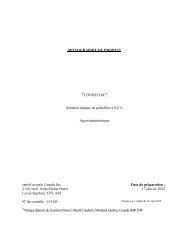Apidra (insulin glulisine) - Sanofi Canada
Apidra (insulin glulisine) - Sanofi Canada
Apidra (insulin glulisine) - Sanofi Canada
Create successful ePaper yourself
Turn your PDF publications into a flip-book with our unique Google optimized e-Paper software.
Preparing the Dose<br />
1. To avoid medication errors, check the label on the<br />
SoloSTAR pen to make sure you have the correct<br />
<strong>insulin</strong>. The APIDRA SoloSTAR is blue.<br />
2. Inspect the <strong>insulin</strong>. APIDRA should be a clear and<br />
colorless solution with no visible particles. Do not<br />
use it if you notice anything unusual in the<br />
appearance of the solution. Do not use the <strong>insulin</strong><br />
after the expiry date on the label.<br />
3. Make sure the <strong>insulin</strong> is at room temperature to<br />
minimize local irritation at the injection site.<br />
4. Wash your hands.<br />
5. It is not necessary to shake or rotate the<br />
SoloSTAR before use.<br />
6. Remove the protective cap.<br />
7. Follow the SoloSTAR directions for attaching<br />
and changing the needle.<br />
8. Check the SoloSTAR for air bubbles. If bubbles<br />
are present, remove them as instructed in the<br />
SoloSTAR directions.<br />
9. Follow the SoloSTAR directions for performing<br />
the Safety Test.<br />
10. Set the SoloSTAR to the correct APIDRA dose as<br />
instructed in the SoloSTAR directions.<br />
11. There is no relevant difference in absorption of<br />
APIDRA between abdominal, thigh, buttock or<br />
upper arm subcutaneous injection areas. However,<br />
injection sites within an injection area (abdomen,<br />
thigh, buttock or upper arm) must be rotated from<br />
one injection to the next.<br />
12. Cleanse the skin with alcohol where the injection<br />
is to be made.<br />
13. Pinch and hold the skin and insert the needle<br />
attached to the SoloSTAR as instructed by your<br />
health professional.<br />
14. To inject APIDRA, follow the directions for the<br />
SoloSTAR.<br />
15. Slowly count to 10 before removing the needle<br />
from the injection site and gently apply pressure<br />
for several seconds. DO NOT RUB THE AREA.<br />
16. Remove the needle from the SoloSTAR<br />
immediately after each injection as instructed in<br />
the directions for the SoloSTAR. Dispose of the<br />
needle appropriately. Do not reuse the needle.<br />
SIDE EFFECTS AND WHAT TO DO ABOUT<br />
THEM<br />
COMMON PROBLEMS OF DIABETES<br />
Hypoglycemia (Insulin Reaction)<br />
Hypoglycemia (too little glucose in the blood) is one of<br />
the most frequent adverse events experienced by<br />
<strong>insulin</strong> users. It can be brought on by situations such<br />
as:<br />
IMPORTANT: PLEASE READ<br />
• intercurrent conditions (illness, stress, or<br />
emotional disturbances),<br />
• accidental injection of an increased <strong>insulin</strong><br />
dose,<br />
• malfunction and/or misuse of medical<br />
devices,<br />
• too-low food intake, or skipped meals,<br />
• an increase in exercise,<br />
• a new <strong>insulin</strong> type or schedule,<br />
• some new medications, including<br />
prescriptions, over-the counter medications,<br />
herbs, vitamins and street drugs.<br />
Symptoms of mild to moderate hypoglycemia may<br />
occur suddenly and can include:<br />
• abnormal behavior (anxiety, irritability,<br />
restlessness, trouble concentrating, personality<br />
changes, mood changes, confusion or<br />
nervousness),<br />
• fatigue,<br />
• tingling in your hands, feet, lips, or tongue,<br />
• tremor (shaking),<br />
• unsteady gait (walking),<br />
• dizziness, light-headedness, or drowsiness,<br />
• headache,<br />
• blurred vision,<br />
• slurred speech,<br />
• palpitations (rapid heartbeat),<br />
• cold sweat,<br />
• pale skin,<br />
• nightmares or trouble sleeping,<br />
• nausea,<br />
• hunger.<br />
Mild to moderate hypoglycemia can be treated by<br />
consuming foods or drinks that contain sugar. Patients<br />
should always carry a quick source of sugar, such as<br />
candy, juice or glucose tablets, prominently labelled<br />
for rescuers. Contact your health professional about<br />
appropriate proportions of carbohydrates.<br />
Signs of severe hypoglycemia can include:<br />
• disorientation,<br />
• convulsions,<br />
• loss of consciousness,<br />
• seizures.<br />
Severe hypoglycemia may require the assistance of<br />
another person. Patients who are unable to take sugar<br />
orally or who are unconscious may require an injection<br />
of glucagon or should be treated with intravenous<br />
administration of glucose by medical personnel.<br />
Without immediate medical help, serious reactions or<br />
even death could occur.<br />
The early warning symptoms of hypoglycemia may<br />
be changed, be less pronounced, or be absent, as for<br />
Page 59 of 61

















